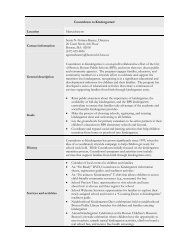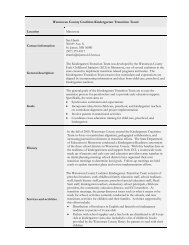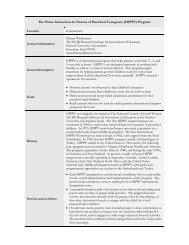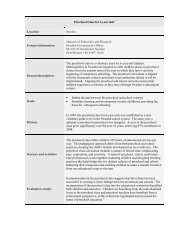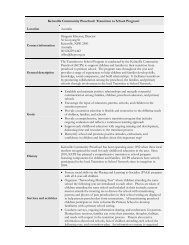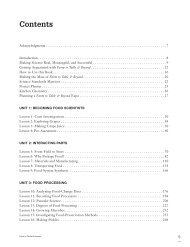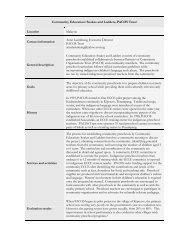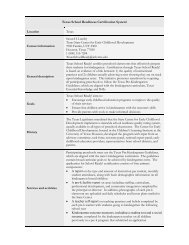Proceedings of the Fourth Annual Teachers College Educational ...
Proceedings of the Fourth Annual Teachers College Educational ...
Proceedings of the Fourth Annual Teachers College Educational ...
You also want an ePaper? Increase the reach of your titles
YUMPU automatically turns print PDFs into web optimized ePapers that Google loves.
Giving Voice to Images: Visual Data as a Means <strong>of</strong> Promoting Youth<br />
Participation<br />
Dino Sossi,<br />
<strong>Teachers</strong> <strong>College</strong>, Columbia University, 525 West 120 th Street, New York, NY, 10027,<br />
Email: dds2130@columbia.edu<br />
Abstract: This exploratory work-in-progress focuses on photo elicitation (PE) as a<br />
methodology to facilitate intellectual and affective student responses with respect to<br />
immigration, national identity, and related issues. In <strong>the</strong> role <strong>of</strong> researcher/classroom<br />
instructor and with <strong>the</strong> assistance <strong>of</strong> <strong>the</strong> regular classroom teacher, we screened a<br />
variety <strong>of</strong> personally produced visual media regarding my family’s immigration experience<br />
with <strong>the</strong> purposes <strong>of</strong> eliciting deeper, thicker responses than normal curricular materials.<br />
Objectives/purposes<br />
This work-in-progress focuses on photo elicitation as a methodology to facilitate student interview<br />
responses with respect to national identity. The researcher utilized a personal photo gallery to elicit<br />
intellectual and affective responses to <strong>the</strong>se images in terms <strong>of</strong> student conceptions <strong>of</strong> <strong>the</strong>ir own national<br />
identities.<br />
Perspective(s) or <strong>the</strong>oretical framework<br />
Identifying Key Issues from Existing Sources<br />
Photo elicitation has been defined as “a method <strong>of</strong> using photographs to guide interviews and ask<br />
questions about social, cultural, and behavioral realities” (Suchar, 1997, p. 34). Photo elicitation is “based<br />
on <strong>the</strong> simple idea <strong>of</strong> inserting a photograph into a research interview” (Harper, 2002, p. 13) and makes a<br />
case for its utility, specifically in <strong>the</strong> fields <strong>of</strong> anthropology and sociology. Cameras have been utilized<br />
tools to conduct research from as far back as <strong>the</strong> 1940’s (Mead and Bateson, 1942). Photo elicitation as a<br />
specific methodological technique started in <strong>the</strong> work <strong>of</strong> John Collier. Collier believed that photography<br />
afforded <strong>the</strong> researcher <strong>the</strong> ability to more efficiently analyze social settings such as <strong>the</strong> workplace and<br />
dwellings that surpassed discussions with subjects that were focused solely on written or verbal<br />
interviews (1967). Collier initially used photo elicitation to understand how families were able to adapt<br />
when it came living in residence among ethnically diverse groups as well as new forms <strong>of</strong> work in urban<br />
factories (Harper, 2002, p. 14). It also spoke <strong>of</strong> <strong>the</strong> modest beginnings <strong>of</strong> photo elicitation in <strong>the</strong> field <strong>of</strong><br />
anthropology and greater reception in visual sociology (Harper, 2002, p. 15).<br />
Since its inception, photo elicitation has been implemented in fields as diverse as social class/social<br />
organization/family (Harper, 2002, p. 16), community and historical ethnography (Harper, 2002, pp. 16-<br />
18), identity/biography/autobiography (Harper, 2002, pp. 18-19), and culture/cultural studies (Harper,<br />
2002, pp. 19-20).<br />
Photo elicitation consists mainly <strong>of</strong> two types. Photos can originate from ei<strong>the</strong>r <strong>the</strong> researcher or<br />
interviewee (Clark-Ibánez, 2004, p. 1509). The second type, photos taken by interviewees is called photoelicitation<br />
“autodriven” interviews (Clark-Ibánez, 2004, p. 1509). For example, researchers can use<br />
photographs to expand on questions. At <strong>the</strong> same time, participants can use photographs to share<br />
different parts <strong>of</strong> <strong>the</strong>ir lives (Clark-Ibánez, 2004).<br />
Positives and Negatives <strong>of</strong> Photo Elicitation<br />
A number <strong>of</strong> studies apply photo elicitation techniques in many settings which helps bring <strong>the</strong> positive and<br />
negatives <strong>of</strong> using this technique into sharp relief.<br />
Positives<br />
Clark-Ibánez (2004), in <strong>the</strong> context <strong>of</strong> school ethnographies and inner-city childhood studies, found that<br />
conducting group interviews using photo elicitation was useful for at least two reasons. First, it revealed<br />
67



